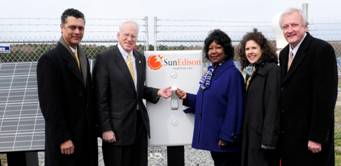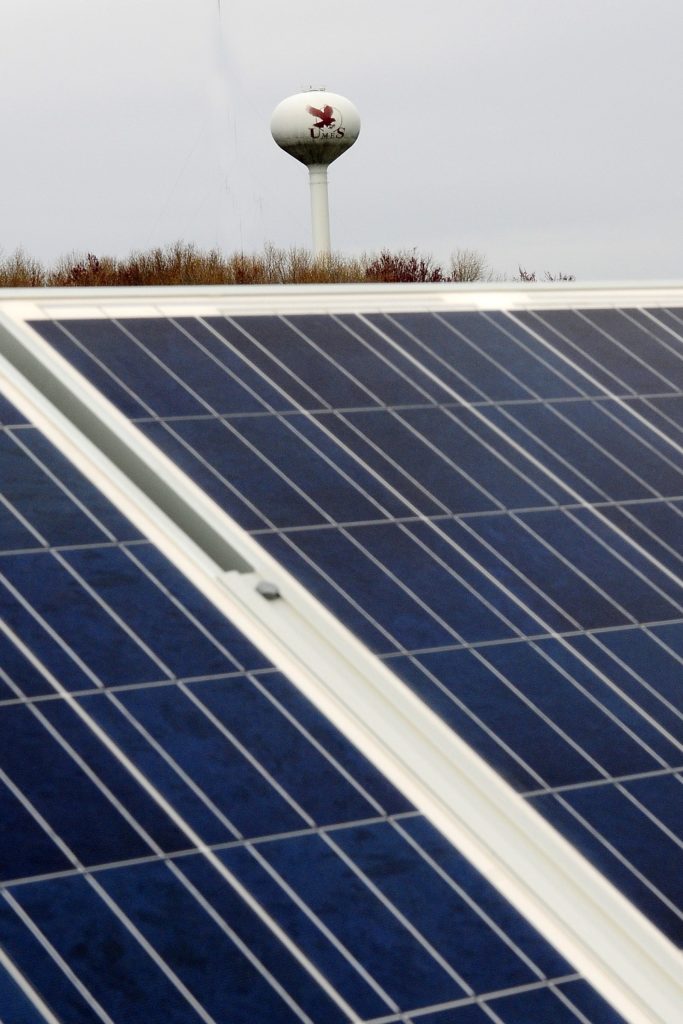Tuesday, March 29, 2011

PRINCESS ANNE, MD – (March 28, 2011) – UMES is now using electric energy produced by a 2.2 megawatt solar-energy facility on the land-grant institution’s campus.
An impressive grid of 7,800 collection panels occupy 17 acres on a former corn field, making it the largest concentration of photovoltaic modules on one site in Maryland, according to SunEdison, the company that built and will operate the facility.
“This is historic for the University of Maryland Eastern Shore,” President Thelma B. Thompson said. “We are part of a world-wide effort to seek clean energy and renewable energy. For UMES to be on the cutting edge of this is extremely exciting for me, our students and our faculty here.”
Located on land adjacent to Tom Nichols Road off state Rt. 388 east of Princess Anne, the solar farm will enable UMES to reduce its energy bills over the next 20 years.
Dr. Ron Forsythe, vice president for UMES’ Division of Technology and Commercialization, estimates the solar farm currently is capable of generating 15 percent of the electricity the campus uses.
The solar panels should produce more than 3.3 million kilowatt hours (kWh) of energy in its first year – enough to provide all the electricity that 315 average American homes would use in a year.
During a February test, the solar farm generated about 400,000 kWh of energy, Forsythe said. When the campus is closed for breaks and electricity demand is low, Forsythe said UMES may be able to transfer electricity from the solar farm back to the energy grid and receive a credit toward future bills.

The university and SunEdison celebrated a formal activation event on March 28, which attracted local and state dignitaries, educators, environmentalists and Dr. William E. Kirwan, the University System of Maryland’s chancellor.
Kirwan described the UMES/SunEdison partnership as mutually beneficial, especially since the state had no upfront investment.
“Perhaps most importantly, the people of Maryland will reap the enormous benefit of having literally millions of pounds of pollutants not released into the atmosphere as this power is generated,” Kirwan said.
SunEdison projects the long-term environmental impact of UMES’ solar farm would be equivalent to a reduction of more than 121 million pounds of carbon dioxide emissions over the 20 years of its production life – or what an estimated 11,800 cars currently produce in one year.
The rising price of energy UMES uses led it in 2007 to look for ways to cut those expenses in lieu of passing them on to students.
Forsythe, representing UMES, struck a service agreement with SunEdison to design, construct and operate the solar farm. The Beltsville, Md.-based company financed it at no cost to UMES or the state of Maryland.
In return, UMES will purchase power from the solar farm at long-term predictable rates to offset the university’s demand from the energy grid.
UMES’ solar farm is another example of Thompson’s vision of what an 1890 land-grant institution should strive to be in the 21st century.

Thompson, who recently announced her retirement this August, sees research and entrepreneurship coming together at UMES to provide a learning environment capable of producing well-trained professionals.
“Everybody is looking at fuels and new sources of energy,” she said. “I want to see our engineering and construction management students exposed to the technology behind solar power so they can go out in the world and make a difference.”
Kirwan called developing and using clean, renewable “a huge priority” for all USM institutions.
“The crown jewel is this 17-acre solar farm,” he told a crowd of nearly 150 people.
UMES is looking for other ways to cut its energy costs. Forsythe has had preliminary talks with a company interested in building wind-powered generators – possibly capable of produce 10 megawatts of electricity for the campus.
Forsythe said he’s also hopeful the solar farm project will stimulate business growth and entrepreneurs to step forward with economic development ideas that will benefit the community UMES serves.
Top photo: Dignitaries “flip the switch” to signal the formal start of electricity production by the UMES/SunEdison 2.2 megawatt solar farm. Pictured, from left, are Dr. Ronald Forsythe, vice president for technology and commercialization, UMES; Chancellor William Kirwan, University System of Maryland; President Thelma B. Thompson, UMES; Franny Yuhas, Eastern Region sales manager, SunEdison; and Sen. James Mathias, D-38-Worcester.
Want to see more about the new UMES solar farm? Visit these links:

